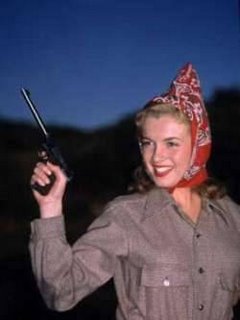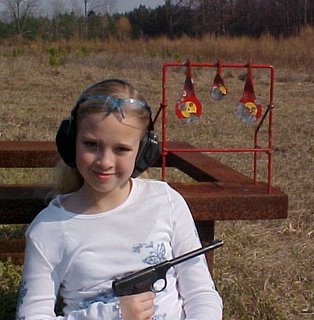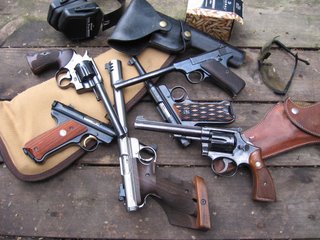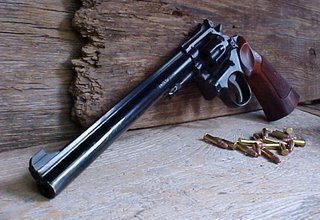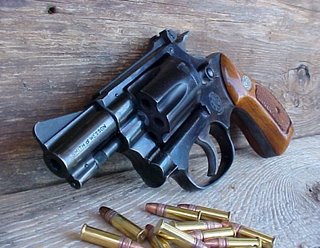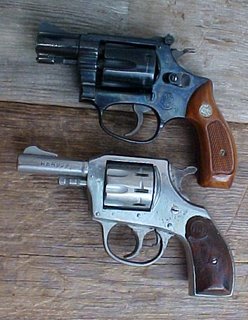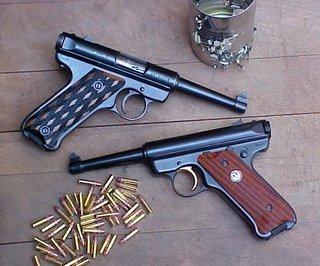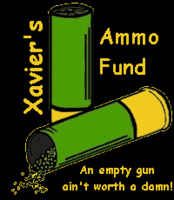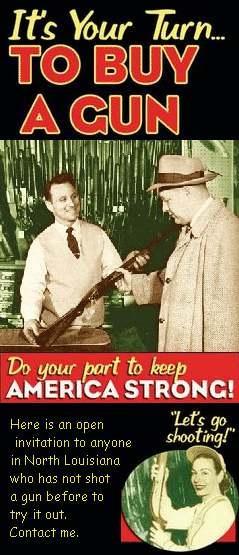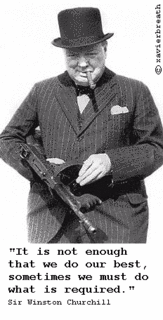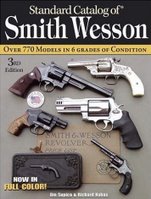In 1949, small advertisements appeared in sporting magazines announcing a new pistol. "The first overall improvement in automatic pistol design since the Browning patent of 1905.

For simplicity, strength, and handsomeness it has no equal." The pure audaciousness of
Bill Ruger's advertisements in retrospect was absolutely on target. The Ruger Standard was a totally new concept for a .22 pistol. It had a tubular receiver with a bolt that fit inside. The receiver was secured atop a grip frame that was reminiscent of a Luger. The bullet exited a tapered barrel that further enhanced the Luger likeness. Some may have been confused over the Ruger name, thinking the pistol was a 22 caliber Luger, but the $37.50 price beat the pants off any other rimfire pistol on the market. Far from being a detriment, the Germanic styling gave the pistol a flair that was quickly assimilated into the American shooting culture. In 1950, the Ruger Target was quickly introduced with a six and 7/8 inch barrel, an adjustable rear sight, an under cut front sight blade to minimize glare, as well as an improved trigger.
The Ruger Standard and Target had no bolt hold back mechanism, and six groove, 1:14 right hand twist rifling in it's barrel. The heel released magazine contained nine rounds. The Ruger Standard stamped and welded grip frame was unique for it's time. It was the tubular receiver and the stamped and welded grip frame that kept the Ruger Standard's price below that of it's competitors.

Adorning the left grip panel was a red eagle medallion, derived from traditional European eagle motifs by Ruger’s partner, Alex Sturm. When Sturm died in 1951, the background for the eagle medallion was changed to black.
Over time, the Standard became available with a variety of barrel lengths, and adjustable sights. In 1971, the dies that the Strum-Ruger corporation used to stamp the grip frames finally wore out. New dies were formed allowing the magazine follower button to be on the left, rather than on the right as was the case with the earlier models. The new style grip frame was designated the A-100. Previous magazines would not fit in the A-100 grip frame, but the newer magazines fit both styles of pistol. The change was a portent of changes on the horizon.
In 1982, Bill Ruger added a bolt hold back mechanism, actuated by the flipped magazine button on the A-100 series pistols, and the
Ruger MKII was born. The Ruger MKII, in all it's variations, is considered by many to be the pinnacle of Bill Ruger's achievements. For many older shooters, the Ruger Standard was the first auto-pistol they ever fired. The MKII introduced an entire new generation to the shooting sports. To commemorate the conclusion of the Ruger Standard era, Sturm-Ruger produced 5000 stainless steel Standard pistols engraved with Bill Ruger's signature on the receiver.

The new MKII Rugers came with ten round magazines, making a dollar box of 50 rounds an even five magazine box. The safety of the MKII was designed as well to allow for a visual inspection of the chamber with the sear locked in place. Stainless steel MKII pistols were introduced in 1982, and a ten inch bull barrel model was added to the line-up in 1984. In 1986, the competition grade Mark II Government Target Model was released along with proof targets confirming it's accuracy. A slab side barreled version of the Government Target Model was introduced in 1991. It was designated the Competition Model.
1993 brought the Ruger 22/45, a polymer framed version with integral grip panels that replicated the grip angle of the venerable 1911. The 22/45 not only mimicked the 1911 in it's grip angle, but the magazine release was moved to the 1911 location, behind the hooked triggerguard.
Finally, in 2004, the MKII was superseded by the
Ruger MKIII. The MKIII gave shooters the magazine release where many had wanted it, beside the triggerguard.

The MKIII also incorporated some less desirable features, however, including a loaded chamber indicator, a magazine disconnect safety, and an internal locking device. While many new shooters may view the new innovations as improvements, older shooters frequently see them as unnecessary and unwanted gilding on a perfect lily.
In 1989, Bill Ruger made some unfortunate statements. In a letter to Congress, he suggested the implementation of a 10 round magazine for all semi-auto handguns, and a ban on the production of full capacity magazines. Bill Ruger later claimed "no honest man needs more than 10 rounds in any gun," in an interview with Tom Brokaw. Congress followed the suggestion and incorporated it into the Assault Weapons Ban of 1994. The AWB sunsetted on September 13, 2004. Bill Ruger died on July 6, 2002. Some gun owners still hold a grudge over those statements, but I figure Bill Ruger is dead and so is the legislation his words helped pass. The pistols his company produced are still some of the most enduring in the world.
Just like in 1949, the Ruger rimfire pistols remain an excellent value. I personally prefer the MKII above all others, but I will not pass on a nice Ruger Standard if I ever see one for sale again while my pockets still jingle.

I own several Ruger MKII's. Some I use to instruct new shooters, one I use for target shooting, and one I carry as a fishing pistol. I like to personalize my handguns a bit, and the MKII allows for that. I like a
Volquartsen trigger and sear. I always keep an eye out for interesting grips, as well as used pistols.
When Ruger MKII pistols appear on the used gun market, they generally change hands for between $150 and $200, depending on finish condition. A used Ruger MKII is invariably a safe purchase, assuming the bore is not plugged with rust. The inherent durability and reliability of the design makes for a pawn shop treasure that frequently needs nothing done to it at all. At a time that ammunition costs are escalating with no end in sight, a 22 caliber pistol makes more sense than ever.
50 Years of Ruger Auto PistolsRuger MKII Dis/Re-assembly Instructions DetailedRuger MKII Internal Disassembly and Reassembly InstructionsSerial NumbersRuger Standard
1949 1
1950 2416
1951 11597
1952 32905
1953 49019
1954 68958
1955 97358
1956 115523
1957 128244
1958 148222
1959 169400
1960 179712
1961 194484
1962 217767
1963 239621
1964 250296
1965 276308
1966 406740
1967 436226
1968 463239
1969 10-00001
1970 10-38890
1971 10-75016
1972 11-26288
1973 11-72924
1974 12-22449
1975 12-81988
1976 13-48646
1977 13-99097
1978 14-69121
1979 15-36233
1980 16-06785
1981 16-82837
1982 17-70981
Ruger MKII
1982 18-00001
1983 18-50048
1984 19-31711
1985 211-13150
1986 212-08560
1987 212-91364
1988 213-90898
1989 214-85593
1990 215-61938
1991 216-68349
1992 217-48014 and 218-00001
1993 219-37950 and 218-05550
1994 219-90370 and 218-26000
1995 221-20943 and 218-45600
1996 221-36504 and 218-59250
1997 221-55005 and 218-68650
1998 221-95002 and 218-95440
1999 222-36510
2000 223-42679
2001 224-21283
2002 224-82446
2003 225-18909
2004 225-60111
2005 225-84467
Labels: 22 Caliber Handguns, Ruger
 has given it his recommendation in a recent blog article. The little Walther has many fans. They love the German pea shooter for it's size, and it's mimicry of the larger Walther P99.
has given it his recommendation in a recent blog article. The little Walther has many fans. They love the German pea shooter for it's size, and it's mimicry of the larger Walther P99.  Many opinions on the internet should be taken with a healthy dose of skepticism, but when corroborating photography accompanies the reports, and time and again, the slides are shown exhibiting failures in the same areas, it behoves the reader to take notice and pay attention.
Many opinions on the internet should be taken with a healthy dose of skepticism, but when corroborating photography accompanies the reports, and time and again, the slides are shown exhibiting failures in the same areas, it behoves the reader to take notice and pay attention.  it is hard to deny that the subsequent cracks that appeared with frequency at the slide stop notch might be indicative of something else. That something else just might be a pot metal slide that would make a Lorcin look like a forged steel wonder gun.
it is hard to deny that the subsequent cracks that appeared with frequency at the slide stop notch might be indicative of something else. That something else just might be a pot metal slide that would make a Lorcin look like a forged steel wonder gun. 





















